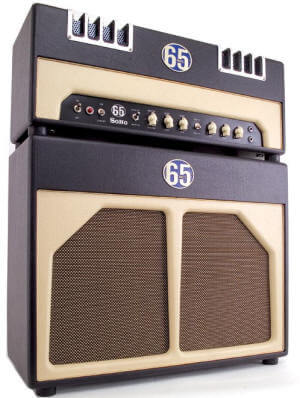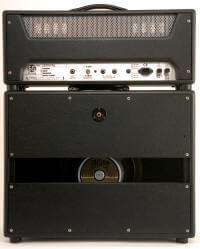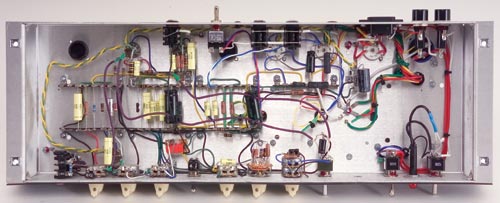
Southern California’s 65 Amps has garnered more attention in a shorter amount of time than almost any boutique amp outfit in recent memory — save, perhaps, its So-Cal-based compatriots, Divided By 13. The company has already earned due recognition for the 35-watt Marquee Club, 45-watt Royal Albert, and, in particular, the conservatively spec’d, but boisterously outspoken 18-watt London 18. All are decidedly Brit-inspired, with dual-channel preamps that employ a pair of Vox’s greatest contributions to tone: the simple EF86-based channel, and the interactive Top Boost channel. Against this backdrop, the SoHo head being reviewed here is the new kid in town, and it’s primed to bust out with a little sibling rivalry — if not an all-out Cain and Abel conflict.
Where the other 65 Amps models show a clear lineage from classic Brit tube topologies, the SoHo hints that its own conception might have occurred during a mid-morning visit from the milkman while mom was home alone. It’s a fairly simple amp compared to the two-channel, eight-knob London 18, but there’s nothing quite like it on planet rock. Ostensibly a single-channel, 20-watt, EL84-based all-tube design with simple controls, it’s the amp’s “little more” that really sets it apart.
65 Amps founders Dan Boul and Peter Stroud clearly like a challenge, and the EF86 pentode preamp tube — which can offer fat, wide, and dynamic tones when it works well — that so many makers have found trouble with again graces the first gain stage of this circuit. While just Volume, Treble, Bass, and a bypassable Master govern this pentode’s fury in “standard” (Bump Off) mode, the Bump function is what really sends this design into another dimension. It’s a footswitchable mid boost of sorts (footswitch included), but rather than being preset like most of the breed, the SoHo’s Bump has its own Tone and 6-position Level control. It can either subtly or radically affect the response and midrange content — and thereby the entire tone and gain structure — of the amplifier. And while it isn’t anything like traditional channel switching (as it only inserts another stage within the amp’s lone channel), 65 contends it’s more than enough to provide a viable lead voice at the tap of a toe.

The SoHo’s speaker cabinet is a semi-open-back design loaded with a Celestion G12H-30 or an optional Celestion Alnico Blue.
To add to the novelty of the Bump function, the SoHo’s Master Volume hides a few tricks of its own. Rather than simply reining in output levels, it is what 65 calls a “reductive master,” which adds a little gain when it’s in-circuit, and it also adjusts the tone stack’s frequency response as you roll it down in order to compensate for the way the human ear perceives frequencies differently at different volumes. Flip the 1000-volt military-grade toggle switch on the front panel to Master Off, and the amp performs as if this unusual master circuit didn’t exist — because, electronically, it doesn’t.
“We wanted to have a master that retains a natural tone and feel without as much of the grit and fizz normally associated with master volumes,” says Boul. “It also had to be completely bypassable, and, when activated, it would allow the user to have a new vocabulary of tone — even at high volumes.”
The SoHo’s stylish blending of Brit-inspired retro esthetics with contemporary touches such as modern cooling vents and a brushed aluminum logo exudes a look of quality from the outside, and a probe inside the box reveals a first-class effort from every perspective. From the N.O.S. Tesla/RFT EF86 to SoZo signal caps to Mercury Magnetics transformers to ceramic and Micalex tube sockets, the SoHo is loaded with top-rate components. The workmanship is top-notch. The circuit is immaculately laid out between parallel rows of terminal strips mounted directly to the aluminum chassis, wire runs are neat and economical, and every mechanical component appears intended to last the life of the amp. In addition to the EF86 (which has a double dose of rubber insulation to guard against microphonics), there’s a pair of JJ 12AX7s, a pair of matched and tested JJ/Tesla EL84s, and an Electro-Harmonix EZ81 rectifier. The latter is a big part of the magic in many a recently issued, EL84-based AC15-inspired amp — it provides DC voltage levels that EL84s thrive on, and just enough sag to offer some tactile compression in playing feel, without going overly mushy.
Our review sample came with an open-backed 1×12″ extension cab made from rugged 11-ply Baltic birch, covered in matching two-tone vinyl, and loaded with a Celestion G12H-30 (available with Celestion Alnico Blue for $895; a 2×12 cab with one G12H-30 and one Alnico Blue is $949).

The SoHo starts with a “standard” Volume/Treble/Bass preamp, but its Bump stage and unusual Master Volume increase its versatility exponentially.
Regarding functionality, one of the first things to note is that you need to throw any conceptions of the traditional Master Volume arrangement right out the window. For example, playing with the Volume at 11 o’clock and the Master set to noon, butoff, then switching to Master On, elicits a considerable increase in volume, whereas you’d normally expect to have to set the Master full up to achieve about the same output level as with the Master off. To add to the fun, the Master maxed/Volume maxed config elicits a lot more gain than Master off/Volume maxed. None of this signifies a flaw, it’s just the way this unusual, yet effective master circuit functions. In effect, it provides yet another voice — or range of voices — rather than just a final governance of level. Nevertheless, it might have been helpful if 65 Amps had named it something else, because it really is a circuit of a different color.
Not only are there four distinctly different textures between the Master On/Off and Bump On/Off options, but the controls are all highly interactive. The Master Volume, Bump Level, and Bump Tone controls enabled me to dial in a surprisingly broad range of drive levels and tones, and the considerable difference in gain levels between the Hi and Lo inputs multiplies the variables even further. Plugged into Hi with Bump and Master off, EQ knobs set to noon, and Volume at around 11 o’clock, I achieved a chimey, buoyant tone with my Telecaster that was great for indie thranging, Beatlesy riffing, and mid-volume Brit-rock rhythm work. By upping the Treble just a little, and injecting the Tele into the Lo input, I coaxed some surprisingly satisfying twang from the SoHo, along with a dose of increased headroom that also served well for shimmery jangle parts.

Top-grade components and tidy, handwired connections scream quality.
Jack back into the Hi input, stomp on the Bump footswitch (Bump level 3 for starters), and this Yank in Brit’s clothing exudes gnarly, raucous transatlantic tricks that approach cranked-brownface Fender Deluxe territory, with bovine mids, recessed but appealing highs, and decent low-end thump. Engage the Master Volume and the aggression intensifies, with a considerable jump in gain — even with the Master only halfway up. Plug in an SG Standard, roll the Master down to around ten o’clock, ratchet Bump up to six, and crank the Volume to four o’clock, and the SoHo belts out astoundingly convincing heavy rock chunk and grind — hairy enough for satisfying nu-metal work at pub-friendly volumes. Similar settings excel at fluty rock lead tones, with a well-partnered rhythm voice when you stomp the switch to take Bump back out of the circuit. Cranked up, there’s plenty of thump and roar here, too. With the stout 1×12 cab, the SoHo easily puts out enough volume for small- to medium-sized club gigs with just a vocal P.A., and it’s loud enough for decent self-monitoring on larger stages where guitar amps would be miked.
In terms of pure tone, the SoHo is perhaps not quite as lush and harmonically bountiful as 65’s London 18, but it punches above its weight a little more confidently, and it might just be a more appealing choice for rockers seeking some versatility in a smaller rig. The more you tweak the SoHo’s controls, the more it reveals previously untapped voices, and the package’s great looks and originality further enhance its appeal. If there really was a sibling rivalry in the 65 Amps family of boutique amps, the SoHo would definitely have to watch its back!
Source: https://mercurymagnetics.com/pages/news/GuitarPlayer/GPMar08.htm